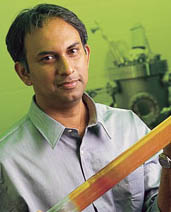For a school that today produces engineers in droves, it is wonderful news that a Loyola old boy is one of the pioneers in nanotechnology. Recently listed by the Scientific American magazine as one of 50 “technology leaders”, Pulickel M. Ajayan of the 1977 batch is the role model from engineering that Loyolites were searching for.
In a Rediff interview Ajayan had said, “My high school (Loyola School, Trivandrum) made a strong impact on me and made me realize that learning is the most exciting thing one can ever befriend.”
When Deepak (1996 ISC) drew my attention to this interview, I contacted Ajayan and requested him to elaborate.
“Loyola was a very professional place with a deep interest in seeing its students succeed. In addition there were lots of opportunities to develop personality, think about things other than just studies and think broadly,” he replied. “Father C.P. Varkey was certainly a strong influence in developing this thought process.”
Ajayan did his early studies in a government school in Kodungallur, and moved to Loyola in standard seven. His stay in the Loyola hostel “helped a lot” as he found himself among students who shared a similar, broad outlook. He is disappointed that the school discontinued the hostel.
“Teachers like M.M. George had a strong influence in my taking up science for my career. The whole teacher community at Loyola when I was there was just excellent. I don’t think I have ever had such a dedicated and loving teacher community after my Loyola experience,” Ajayan wrote to me.
“If I think about influences in my life that had an impact of changing my life, I would say Loyola comes first.” This, from an influential person himself. A few years ago, when ScienceWatch analysed articles on nanotechnology written between 1992 and 2002, Ajayan was the seventh most-cited author in the world.
More on Ajayan and his work, in the Wikipedia
Update: I expanded this blogpost and published an article on Ajayan in The Hindu BusinessLine.

Ashok,
Thanks for your mention of my name as the source, but it was Jiby(http://jiby216.blogspot.com/) who alerted the Orkut community about the rediff.com news item.
Regards,
Deepak
Thats fine, Deepak…thanks for bringing it to Ashok’s notice.
Ashok, all the very best with this initiative. Hope to see a lot of quality writeups about the school and the alumni.
i see you have linked up the school anecdotes here…that was initially meant for my classmates…i would dread some of the teachers whose names find mention there reading this…lol!
Jiby, I enjoyed reading the anecdotes you compiled. Am hoping that a teacher will put a similar list here. 😉 Like Fr Pulickal’s list on the noticeboard.
Oh yeah, those anecdotes were really funny.
Really great to see this write-up, Ashok. This is definitely a huge distinction. Currently, a lot of debate is taking place in the U.S. regarding losing the edge in science & technology.
Will look forward to more of your notes in the future. Hope you’ll be able to find more on our big-time achievers.
This is a good one! Thrilled to see your blog. Must say it was long-awaited. Carry on Blogging!!
Tojo, months ago, I read Thomas Friedman asking Bush to invest in science research. Wonder who the US is losing the edge to, or will soon lose the edge to.
Thanks for the encouragement, guys! The only way I can do more write-ups of this kind is if you folks too do an Ajayan. 🙂 I merely store the honey.
Ashok, great job! I am sure this initiative will be a hit too! And great reading as well. I particularly liked the ARChive idea..I should think of a Beehive perhaps 🙂
Bimal, yours is already a beehive in the blogosphere. I’ve not included it in the Loyola blogroll because you are Percy Blakeney-ish in cyberspace 8) Am impressed by your sustaining power over there. Hope to emulate you here.
For those who may not have seen this – There is a really interesting documentary/DVD from Thomas Friedman – ‘The Other Side of Outsourcing’. He got the idea for his book, ‘The World is Flat’ while working on this project. It has interesting perspectives, including interviews with Narayana Murthy and Azim Premji. Some of us might remember first-hand experiences from work while seeing this.
Ashok, look forward to more of your notes..
Thanks Ashok for not including that 🙂 I hope I can continue to be Blakeneyish and wont get a blackeye for what I do 😐
Never knew that there existed a Loyolite in IT-BHU until one of my mates pointed out to Dr. Ajayan. Hope to carry on the humble tradition.
Varun, does Ajayan figure in BHU folklore already? And best of luck on your journey.
Great! Hopefully, more Loyolites will look to become R&D trendsetters, rather than footsoldiers in the IT (r)evolution.
A video of Prof. Ajayan speaking about nanotechnology can be viewed here: http://www.youtube.com/watch?v=inLm0BeuYPw
Deepak, thanks for posting the YouTube link here.
Big News
I just read this article from The Hindu‘s August 19 edition:
This is a significant achievement. Rensselaer has put this as the main story on their home page. Read more about this from the web site of the Rensselaer Polytechnic Institute: http://news.rpi.edu/update.do?artcenterkey=2280&setappvar=page(1)
Deepak, here’s that story, in The Economist, Aug 14th 2007
‘Storing electricity: It looks good on paper’
http://economist.com/science/tq/displaystory.cfm?story_id=9642197